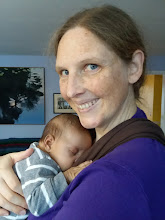Soundtrack for a week in the jungle
Monday, 4:38 pm. “Short Ride in a Fast Machine” (John Adams) The back border of La Selva is about 150 meters higher than the area around the labs, and the part of the Sendero Jaguar that’s paved for bikes crunches its way through the better part of that elevation gain in a little over a kilometer. It’s a long, grinding uphill in the morning, and a thrill ride on the way home. Usually when I’m not burdened with much gear, my strategy is to keep a light seat in case I need to bail on the slippery curve where the leaf-cutter ant nest overflows onto the concrete. Monday afternoon I was carrying two enormous garbage bags of plant samples—and the pole cutter. This evil contraption (and it is evil; I have the scars to prove it) is an extendable metal pole that reaches up to about 10 m to cut branches I wouldn’t otherwise be able to reach. It collapses down to two meters long, short enough to carry on a bike. If you’re crazy, like me. The best way I’ve found to deal with it is to pass the end through one of my backpack straps, lash the cutter head to the handlebars, and pray. Bailing is out of the question. Well, fortunately some deity must have listened, because the rain had washed away enough of the leaf-cutter nest that the trail was clear, and I got to the bottom of the hill in one piece. Very quickly.
Tuesday, 5:56 am. “Try Not To Breathe” (R.E.M.) My friend Alex, a red-haired British woman who is (not without reason) nicknamed “La Loca,” is a plant physiologist. She’s studying how temperature and drought affect plant metabolism, in a series of complex and delicate experiments that always seem to run from 5 am until well after supper. (She also spent a good part of last summer working at a site that was an 8-hr hike from the nearest road, but that’s another story.) The latest experiment involves very precise carbon dioxide measurements on the leaves of drought-stressed plants. The station being packed to capacity, and all the lab space being spoken for, the only place where La Loca could conduct this experiment was underneath Cabina 1, where I happen to live. So, following her adamant instructions, as I walk downstairs on my way to breakfast every morning, past the table covered with plants, tubing, lights, extension cords, and instruments resembling spare parts from the Death Star, I try not to breathe.
Wednesday, 7:25 am – 4:31 pm. “Raindrops Keep Falling on My Head” (who sings that, anyway?) Yes, in fact, raindrops keep falling on just about every part of me. I am reminded of a day a few years ago, the first summer that I spent at La Selva, when I was way out at the back of the station with Pablo (another grad student in my advisor’s lab). It started to pour. I must have looked kind of glum, because Pablo looked back at me and said, “we’re having a rainforest experience. People pay lots of money for this.” I try to keep those words in mind when I stop for the fourth time to dump my brim-full boots.
Thursday, 8:49 pm. “Subterranean Homesick Alien” (Radiohead) As I was getting my laundry out of the dryer—sap-stained t-shirts, colorful sarongs, four pairs of pants with permanent red mud-stains—I noticed something sinuous and shiny moving across the laundry room floor. At first I thought it was a snake, but the shape and the movement were all wrong. It was blunt-ended and seemingly headless, and moved in more of a spiral undulation than a slither. More than anything else, it looked like a giant blue earthworm. An earthworm—as I looked closer—with teeth. It took a few seconds for my brain to dredge up the word: caecilian. A family of eyeless, legless, subterranean amphibians, apparently common in the Neotropics but rarely seen. They don’t come aboveground very often. Maybe the rain brought it out. Up close, it was gorgeous. The ring-shaped scales circling its body were dark blue and faintly iridescent, shading to a lighter blue at the margin. I was suddenly reminded of a conversation with Steven, a herpetology grad student who’s settling in for a long stay at the station. He was recounting a memorable talk at the last Herp Society meeting: Herps in Space. Apparently a professor had gotten funding to go up in the zero-G airplane (“vomit comet”) with a bunch of different herps to see how they reacted to the absence of gravity. Apparently most of them scrambled around trying to grab something. The caecilians just sat there. (“Yeah, they were pretty chill,” Steven recounted. “I guess gravity is not a big part of their worldview.”) It’s amazing, the variety of creatures we share this planet with.
Friday, 6:05 am... to the tune of Daddy Yankee’s “Gasolina,” all together now: A mí me gusta la cafeína (dame más cafeína!), a mí me’ncanta la cafeína (dame más cafeína!)...
Saturday, 7:09 am. “I’ll Fly Away” (traditional; I like Alison Krause’s version). Actually, considering that I don’t have internet access at the moment, by the time I post this I will have flown away already. I’m headed for the ATBC conference (Association for Tropical Biology and Conservation) in Kunming, China. It doesn’t seem quite real yet, even though I’ve just gone over my talk for the umpteenth time, and I’m sitting here writing this in a little hostel right beside the airport in Alajuela, with planes roaring past just overhead. This will be my first international scientific meeting, and I have to say, you can’t get much more international than that. It’s literally on the other side of the world. Thanks to all my funding agencies (UCONN, NSF, and the Ronald Bamford Endowment)!


0 Comments:
Post a Comment
<< Home